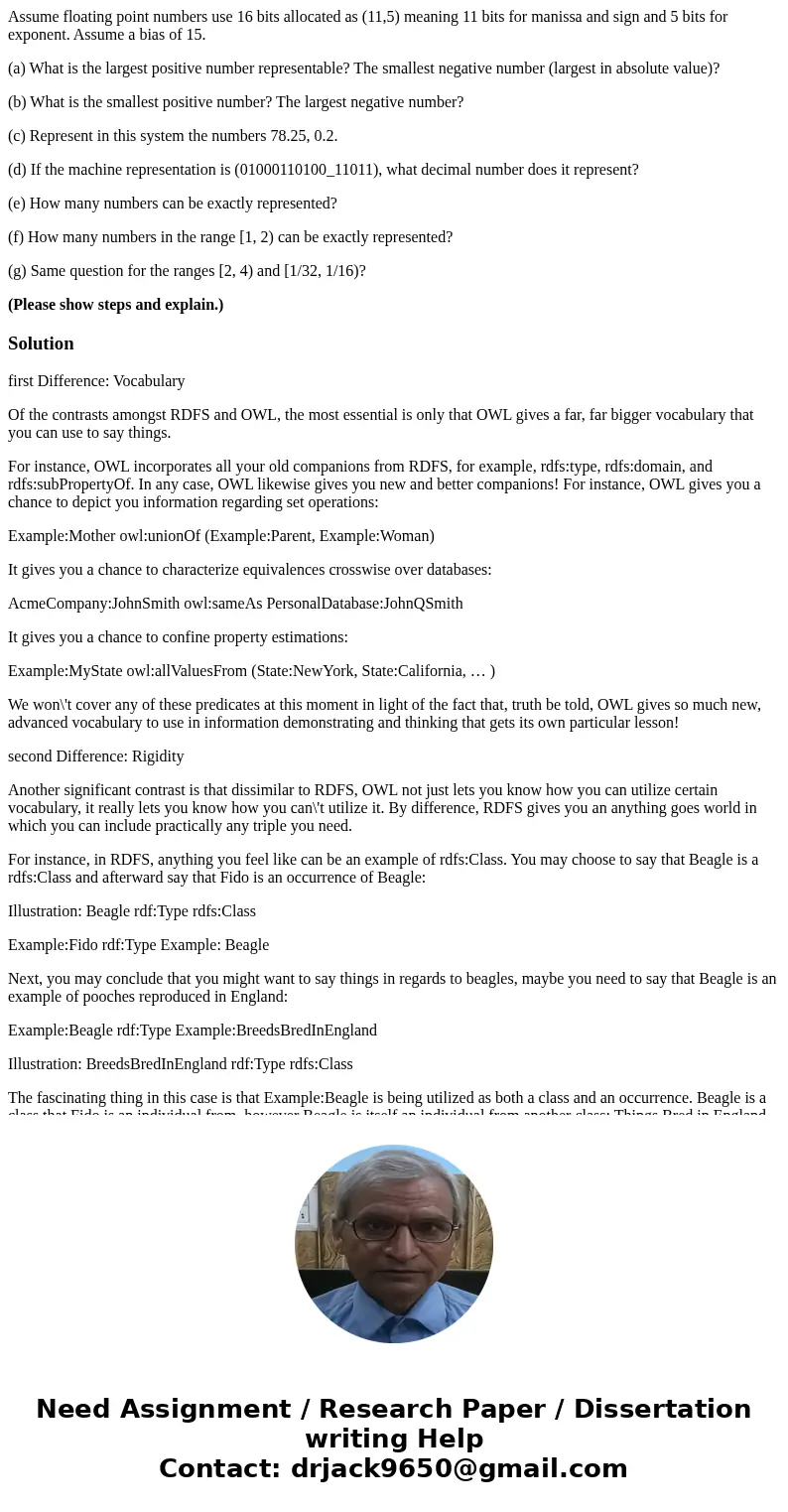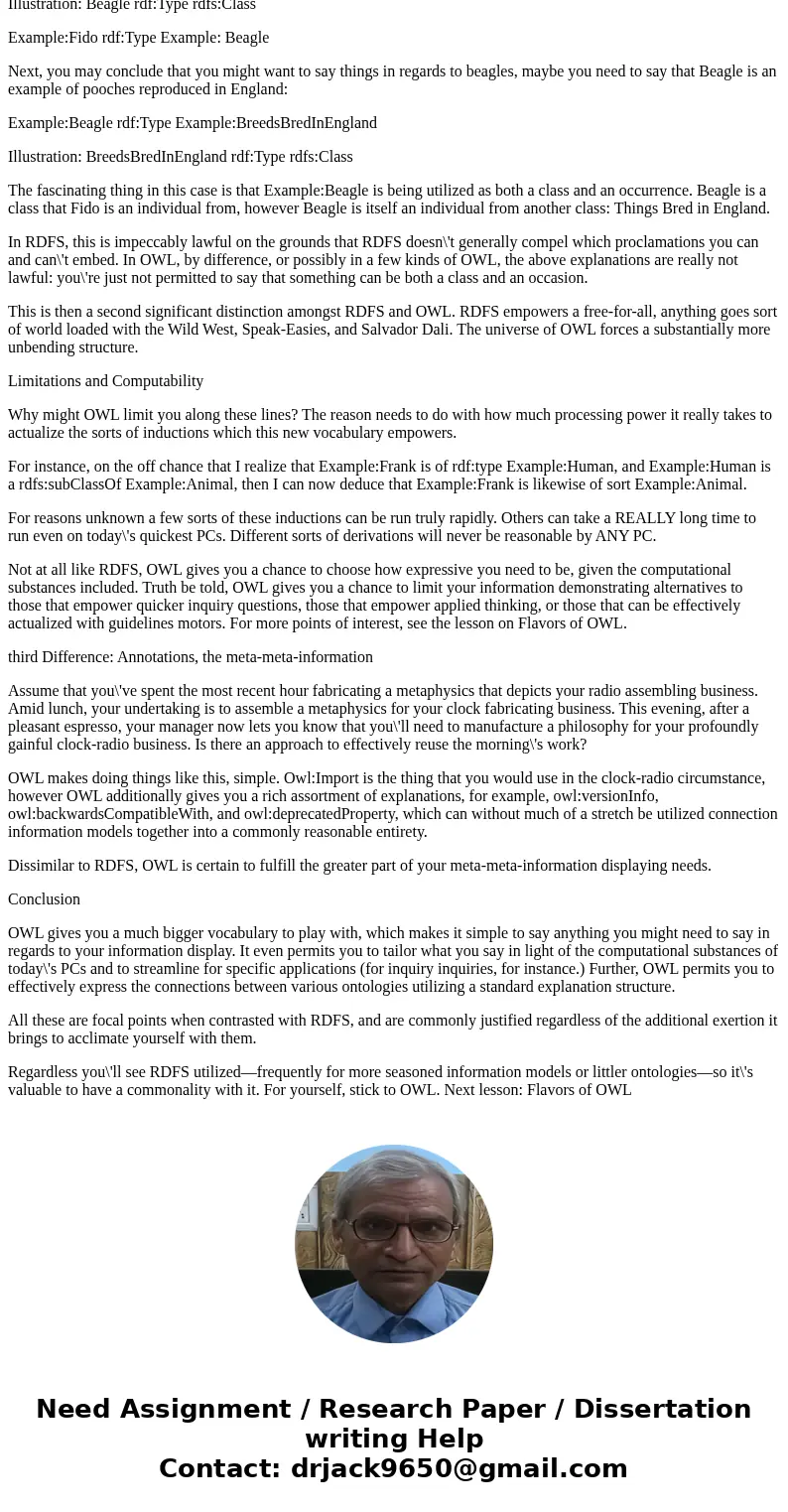Assume floating point numbers use 16 bits allocated as 115 m
Assume floating point numbers use 16 bits allocated as (11,5) meaning 11 bits for manissa and sign and 5 bits for exponent. Assume a bias of 15.
(a) What is the largest positive number representable? The smallest negative number (largest in absolute value)?
(b) What is the smallest positive number? The largest negative number?
(c) Represent in this system the numbers 78.25, 0.2.
(d) If the machine representation is (01000110100_11011), what decimal number does it represent?
(e) How many numbers can be exactly represented?
(f) How many numbers in the range [1, 2) can be exactly represented?
(g) Same question for the ranges [2, 4) and [1/32, 1/16)?
(Please show steps and explain.)
Solution
first Difference: Vocabulary
Of the contrasts amongst RDFS and OWL, the most essential is only that OWL gives a far, far bigger vocabulary that you can use to say things.
For instance, OWL incorporates all your old companions from RDFS, for example, rdfs:type, rdfs:domain, and rdfs:subPropertyOf. In any case, OWL likewise gives you new and better companions! For instance, OWL gives you a chance to depict you information regarding set operations:
Example:Mother owl:unionOf (Example:Parent, Example:Woman)
It gives you a chance to characterize equivalences crosswise over databases:
AcmeCompany:JohnSmith owl:sameAs PersonalDatabase:JohnQSmith
It gives you a chance to confine property estimations:
Example:MyState owl:allValuesFrom (State:NewYork, State:California, … )
We won\'t cover any of these predicates at this moment in light of the fact that, truth be told, OWL gives so much new, advanced vocabulary to use in information demonstrating and thinking that gets its own particular lesson!
second Difference: Rigidity
Another significant contrast is that dissimilar to RDFS, OWL not just lets you know how you can utilize certain vocabulary, it really lets you know how you can\'t utilize it. By difference, RDFS gives you an anything goes world in which you can include practically any triple you need.
For instance, in RDFS, anything you feel like can be an example of rdfs:Class. You may choose to say that Beagle is a rdfs:Class and afterward say that Fido is an occurrence of Beagle:
Illustration: Beagle rdf:Type rdfs:Class
Example:Fido rdf:Type Example: Beagle
Next, you may conclude that you might want to say things in regards to beagles, maybe you need to say that Beagle is an example of pooches reproduced in England:
Example:Beagle rdf:Type Example:BreedsBredInEngland
Illustration: BreedsBredInEngland rdf:Type rdfs:Class
The fascinating thing in this case is that Example:Beagle is being utilized as both a class and an occurrence. Beagle is a class that Fido is an individual from, however Beagle is itself an individual from another class: Things Bred in England.
In RDFS, this is impeccably lawful on the grounds that RDFS doesn\'t generally compel which proclamations you can and can\'t embed. In OWL, by difference, or possibly in a few kinds of OWL, the above explanations are really not lawful: you\'re just not permitted to say that something can be both a class and an occasion.
This is then a second significant distinction amongst RDFS and OWL. RDFS empowers a free-for-all, anything goes sort of world loaded with the Wild West, Speak-Easies, and Salvador Dali. The universe of OWL forces a substantially more unbending structure.
Limitations and Computability
Why might OWL limit you along these lines? The reason needs to do with how much processing power it really takes to actualize the sorts of inductions which this new vocabulary empowers.
For instance, on the off chance that I realize that Example:Frank is of rdf:type Example:Human, and Example:Human is a rdfs:subClassOf Example:Animal, then I can now deduce that Example:Frank is likewise of sort Example:Animal.
For reasons unknown a few sorts of these inductions can be run truly rapidly. Others can take a REALLY long time to run even on today\'s quickest PCs. Different sorts of derivations will never be reasonable by ANY PC.
Not at all like RDFS, OWL gives you a chance to choose how expressive you need to be, given the computational substances included. Truth be told, OWL gives you a chance to limit your information demonstrating alternatives to those that empower quicker inquiry questions, those that empower applied thinking, or those that can be effectively actualized with guidelines motors. For more points of interest, see the lesson on Flavors of OWL.
third Difference: Annotations, the meta-meta-information
Assume that you\'ve spent the most recent hour fabricating a metaphysics that depicts your radio assembling business. Amid lunch, your undertaking is to assemble a metaphysics for your clock fabricating business. This evening, after a pleasant espresso, your manager now lets you know that you\'ll need to manufacture a philosophy for your profoundly gainful clock-radio business. Is there an approach to effectively reuse the morning\'s work?
OWL makes doing things like this, simple. Owl:Import is the thing that you would use in the clock-radio circumstance, however OWL additionally gives you a rich assortment of explanations, for example, owl:versionInfo, owl:backwardsCompatibleWith, and owl:deprecatedProperty, which can without much of a stretch be utilized connection information models together into a commonly reasonable entirety.
Dissimilar to RDFS, OWL is certain to fulfill the greater part of your meta-meta-information displaying needs.
Conclusion
OWL gives you a much bigger vocabulary to play with, which makes it simple to say anything you might need to say in regards to your information display. It even permits you to tailor what you say in light of the computational substances of today\'s PCs and to streamline for specific applications (for inquiry inquiries, for instance.) Further, OWL permits you to effectively express the connections between various ontologies utilizing a standard explanation structure.
All these are focal points when contrasted with RDFS, and are commonly justified regardless of the additional exertion it brings to acclimate yourself with them.
Regardless you\'ll see RDFS utilized—frequently for more seasoned information models or littler ontologies—so it\'s valuable to have a commonality with it. For yourself, stick to OWL. Next lesson: Flavors of OWL


 Homework Sourse
Homework Sourse